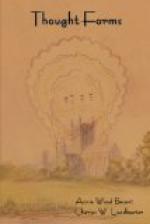If the thought-form be neither definitely personal nor specially aimed at someone else, it simply floats detached in the atmosphere, all the time radiating vibrations similar to those originally sent forth by its creator. If it does not come into contact with any other mental body, this radiation gradually exhausts its store of energy, and in that case the form falls to pieces; but if it succeeds in awakening sympathetic vibration in any mental body near at hand, an attraction is set up, and the thought-form is usually absorbed by that mental body. Thus we see that the influence of the thought-form is by no means so far-reaching as that of the original vibration; but in so far as it acts, it acts with much greater precision. What it produces in the mind-body which it influences is not merely a thought of an order similar to that which gave it birth; it is actually the same thought. The radiation may affect thousands and stir up in them thoughts on the same level as the original, and yet it may happen that no one of them will be identical with that original; the thought-form can affect only very few, but in those few cases it will reproduce exactly the initiatory idea.
The fact of the creation by vibrations of a distinct form, geometrical or other, is already familiar to every student of acoustics, and “Chladni’s” figures are continually reproduced in every physical laboratory.
[Illustration: FIG. 1. CHLADNI’S SOUND PLATE]
[Illustration: FIG. 2. FORMS PRODUCED IN SOUND]
For the lay reader the following brief description may be useful. A Chladni’s sound plate (fig. 1) is made of brass or plate-glass. Grains of fine sand or spores are scattered over the surface, and the edge of the plate is bowed. The sand is thrown up into the air by the vibration of the plate, and re-falling on the plate is arranged in regular lines (fig. 2). By touching the edge of the plate at different points when it is bowed, different notes, and hence varying forms, are obtained (fig. 3). If the figures here given are compared with those obtained from the human voice, many likenesses will be observed. For these latter, the ‘voice-forms’ so admirably studied and pictured by Mrs Watts Hughes,[1] bearing witness to the same fact, should be consulted, and her work on the subject should be in the hands of every student. But few perhaps have realised that the shapes pictured are due to the interplay of the vibrations that create them, and that a machine exists by means of which two or more simultaneous motions can be imparted to a pendulum, and that by attaching a fine drawing-pen to a lever connected with the pendulum its action may be exactly traced. Substitute for the swing of the pendulum the vibrations set up in the mental or astral body, and we have clearly before us the modus operandi of the building of forms by vibrations.[2]




